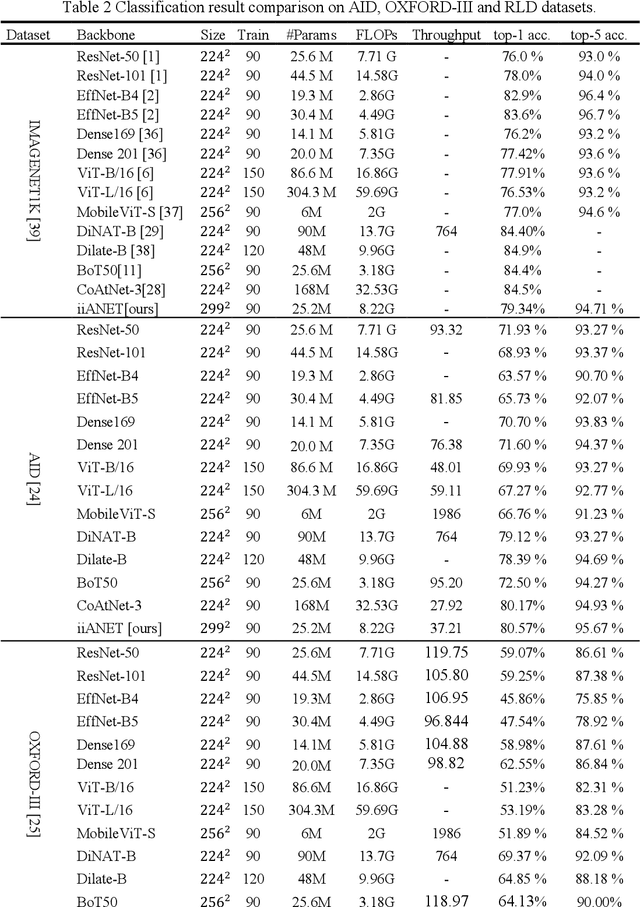Isah Bello
iiANET: Inception Inspired Attention Hybrid Network for efficient Long-Range Dependency
Jul 10, 2024



Abstract:The recent emergence of hybrid models has introduced another transformative approach to solving computer vision tasks, slowly shifting away from conventional CNN (Convolutional Neural Network) and ViT (Vision Transformer). However, not enough effort has been made to efficiently combine these two approaches to improve capturing long-range dependencies prevalent in complex images. In this paper, we introduce iiANET (Inception Inspired Attention Network), an efficient hybrid model designed to capture long-range dependencies in complex images. The fundamental building block, iiABlock, integrates global 2D-MHSA (Multi-Head Self-Attention) with Registers, MBConv2 (MobileNetV2-based convolution), and dilated convolution in parallel, enabling the model to adeptly leverage self-attention for capturing long-range dependencies while utilizing MBConv2 for effective local-detail extraction and dilated convolution for efficiently expanding the kernel receptive field to capture more contextual information. Lastly, we serially integrate an ECANET (Efficient Channel Attention Network) at the end of each iiABlock to calibrate channel-wise attention for enhanced model performance. Extensive qualitative and quantitative comparative evaluation on various benchmarks demonstrates improved performance over some state-of-the-art models.
mAPm: multi-scale Attention Pyramid module for Enhanced scale-variation in RLD detection
Feb 26, 2024Abstract:Detecting objects across various scales remains a significant challenge in computer vision, particularly in tasks such as Rice Leaf Disease (RLD) detection, where objects exhibit considerable scale variations. Traditional object detection methods often struggle to address these variations, resulting in missed detections or reduced accuracy. In this study, we propose the multi-scale Attention Pyramid module (mAPm), a novel approach that integrates dilated convolutions into the Feature Pyramid Network (FPN) to enhance multi-scale information ex-traction. Additionally, we incorporate a global Multi-Head Self-Attention (MHSA) mechanism and a deconvolutional layer to refine the up-sampling process. We evaluate mAPm on YOLOv7 using the MRLD and COCO datasets. Compared to vanilla FPN, BiFPN, NAS-FPN, PANET, and ACFPN, mAPm achieved a significant improvement in Average Precision (AP), with a +2.61% increase on the MRLD dataset compared to the baseline FPN method in YOLOv7. This demonstrates its effectiveness in handling scale variations. Furthermore, the versatility of mAPm allows its integration into various FPN-based object detection models, showcasing its potential to advance object detection techniques.
Exploring the Synergies of Hybrid CNNs and ViTs Architectures for Computer Vision: A survey
Feb 05, 2024Abstract:The hybrid of Convolutional Neural Network (CNN) and Vision Transformers (ViT) architectures has emerged as a groundbreaking approach, pushing the boundaries of computer vision (CV). This comprehensive review provides a thorough examination of the literature on state-of-the-art hybrid CNN-ViT architectures, exploring the synergies between these two approaches. The main content of this survey includes: (1) a background on the vanilla CNN and ViT, (2) systematic review of various taxonomic hybrid designs to explore the synergy achieved through merging CNNs and ViTs models, (3) comparative analysis and application task-specific synergy between different hybrid architectures, (4) challenges and future directions for hybrid models, (5) lastly, the survey concludes with a summary of key findings and recommendations. Through this exploration of hybrid CV architectures, the survey aims to serve as a guiding resource, fostering a deeper understanding of the intricate dynamics between CNNs and ViTs and their collective impact on shaping the future of CV architectures.
 Add to Chrome
Add to Chrome Add to Firefox
Add to Firefox Add to Edge
Add to Edge